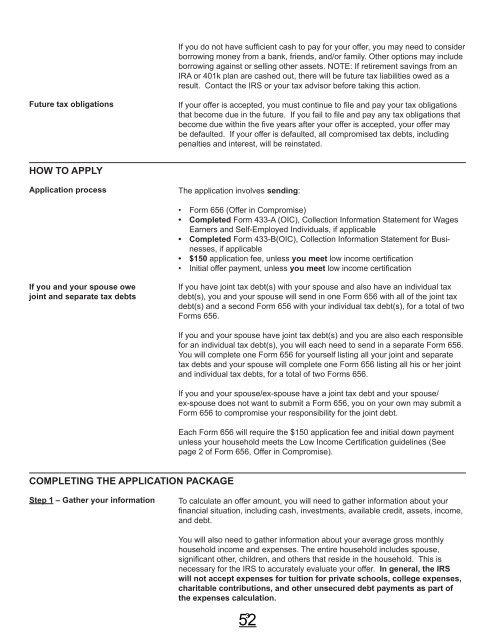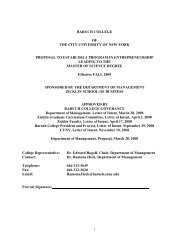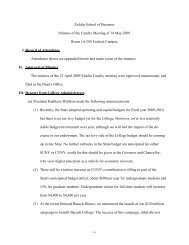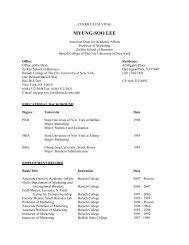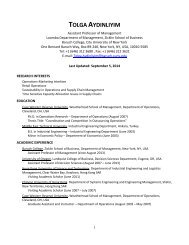Tax Seminar #3 – December 3 2012
Workbook - Zicklin School of Business
Workbook - Zicklin School of Business
You also want an ePaper? Increase the reach of your titles
YUMPU automatically turns print PDFs into web optimized ePapers that Google loves.
If you do not have sufficient cash to pay for your offer, you may need to consider<br />
borrowing money from a bank, friends, and/or family. Other options may include<br />
borrowing against or selling other assets. NOTE: If retirement savings from an<br />
IRA or 401k plan are cashed out, there will be future tax liabilities owed as a<br />
result. Contact the IRS or your tax advisor before taking this action.<br />
Future tax obligations<br />
If your offer is accepted, you must continue to file and pay your tax obligations<br />
that become due in the future. If you fail to file and pay any tax obligations that<br />
become due within the five years after your offer is accepted, your offer may<br />
be defaulted. If your offer is defaulted, all compromised tax debts, including<br />
penalties and interest, will be reinstated.<br />
HOW TO APPLY<br />
Application process<br />
The application involves sending:<br />
• Form 656 (Offer in Compromise)<br />
• Completed Form 433-A (OIC), Collection Information Statement for Wages<br />
Earners and Self-Employed Individuals, if applicable<br />
• Completed Form 433-B(OIC), Collection Information Statement for Businesses,<br />
if applicable<br />
• $150 application fee, unless you meet low income certification<br />
• Initial offer payment, unless you meet low income certification<br />
If you and your spouse owe<br />
joint and separate tax debts<br />
If you have joint tax debt(s) with your spouse and also have an individual tax<br />
debt(s), you and your spouse will send in one Form 656 with all of the joint tax<br />
debt(s) and a second Form 656 with your individual tax debt(s), for a total of two<br />
Forms 656.<br />
If you and your spouse have joint tax debt(s) and you are also each responsible<br />
for an individual tax debt(s), you will each need to send in a separate Form 656.<br />
You will complete one Form 656 for yourself listing all your joint and separate<br />
tax debts and your spouse will complete one Form 656 listing all his or her joint<br />
and individual tax debts, for a total of two Forms 656.<br />
If you and your spouse/ex-spouse have a joint tax debt and your spouse/<br />
ex-spouse does not want to submit a Form 656, you on your own may submit a<br />
Form 656 to compromise your responsibility for the joint debt.<br />
Each Form 656 will require the $150 application fee and initial down payment<br />
unless your household meets the Low Income Certification guidelines (See<br />
page 2 of Form 656, Offer in Compromise).<br />
COMPLETING THE APPLICATION PACKAGE<br />
Step 1 <strong>–</strong> Gather your information<br />
To calculate an offer amount, you will need to gather information about your<br />
financial situation, including cash, investments, available credit, assets, income,<br />
and debt.<br />
You will also need to gather information about your average gross monthly<br />
household income and expenses. The entire household includes spouse,<br />
significant other, children, and others that reside in the household. This is<br />
necessary for the IRS to accurately evaluate your offer. In general, the IRS<br />
will not accept expenses for tuition for private schools, college expenses,<br />
charitable contributions, and other unsecured debt payments as part of<br />
the expenses calculation.<br />
3<br />
52


